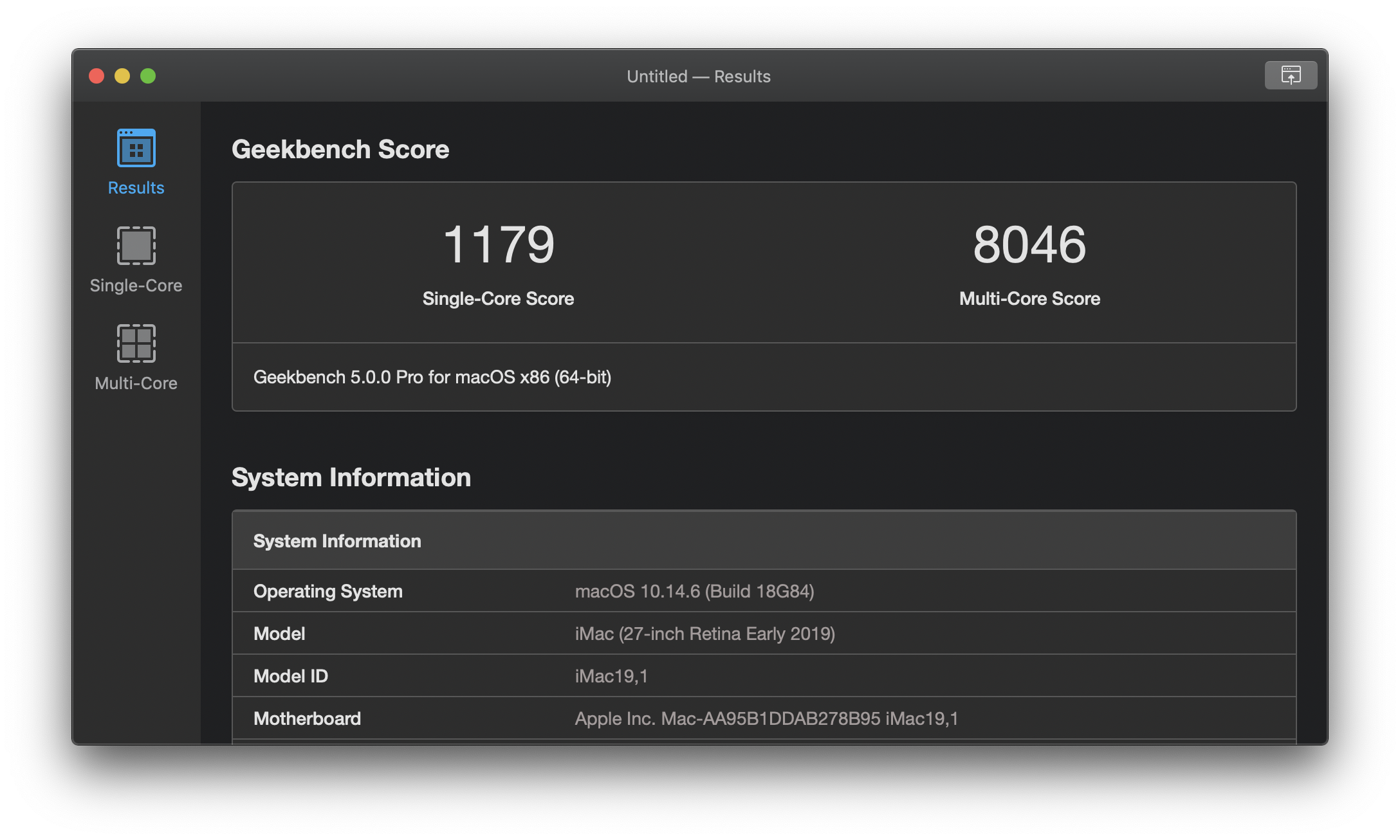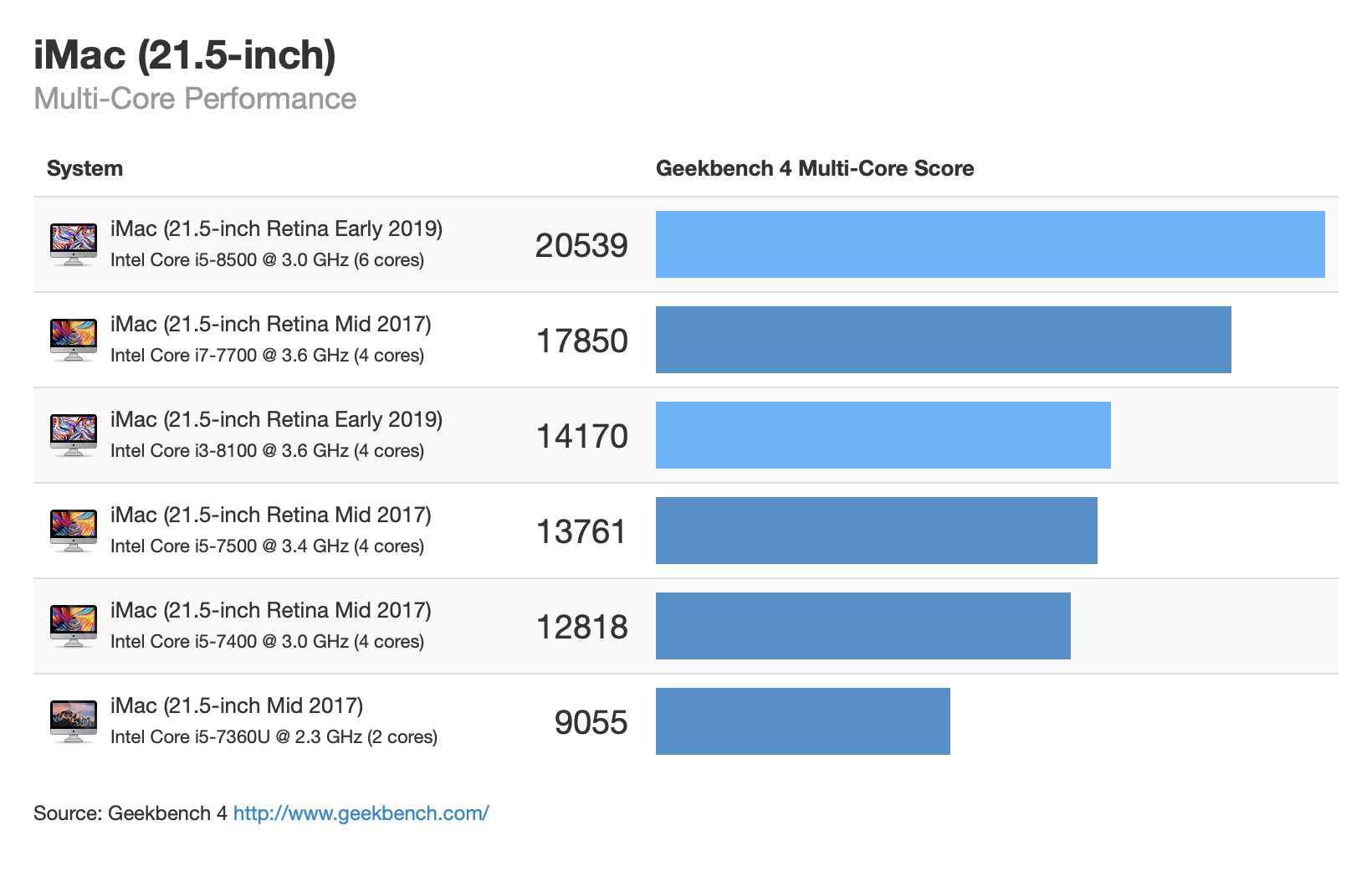Primate Labs has release a major new update of its popular Geekbench performance measurement tool. Geekbench 5 comes three years after the release of Geekbench 4 and features all new test methods, workloads, and a new measurement scale. As such, it should be a much more accurate representation of modern workloads on modern hardware, and the scores are not at all comparable with those from Geekbench 4. Jixipix photo formation pro 1 0 11 percent.
- Geekbench - 9to5Mac. Geekbench Stories January 2, 2020. Geekbench 5.1 delivers CPU and compute performance improvements on Mac and iOS. Michael Potuck - Jan. 2nd 2020 6:14 am PT. Geekbench is out.
- Below are the Geekbench 5 GPU results. The $999 MacBook Air and the $1,299 iMac have a 7-core GPU that's slower than the other M1 Macs, but you probably won't notice a difference in general.

We often use Geekbench here at Macworld to give an overall picture of the CPU and GPU compute performance of iPhones, iPads, and Macs. It's one of the few cross-device and cross-operating-system comparable benchmarks available; while it doesn't paint a perfect picture of the difference in performance between an Intel chip running Windows, an Android phone with a Qualcomm processor, and an iPad with Apple's custom silicon, it is one of the best synthetic benchmarks available to at least attempt to make such a comparison.
What's new in Geekbench 5
Geekbench 5 is out. Fotomagico pro 5 6 8. Post Mac mini results! Gotta add that these guys are still crippling the Mac GPU results. The scores used to be the same as Windows and then last year without any changes on the user side the macOS GPU results came sliding down.

We often use Geekbench here at Macworld to give an overall picture of the CPU and GPU compute performance of iPhones, iPads, and Macs. It's one of the few cross-device and cross-operating-system comparable benchmarks available; while it doesn't paint a perfect picture of the difference in performance between an Intel chip running Windows, an Android phone with a Qualcomm processor, and an iPad with Apple's custom silicon, it is one of the best synthetic benchmarks available to at least attempt to make such a comparison.
What's new in Geekbench 5
Geekbench 5 is out. Fotomagico pro 5 6 8. Post Mac mini results! Gotta add that these guys are still crippling the Mac GPU results. The scores used to be the same as Windows and then last year without any changes on the user side the macOS GPU results came sliding down.
Since we so frequently discuss Geekbench performance results (as in our forward-looking Apple A13 preview), we should reveal a little detail about some of the changes in Geekbench 5. Here's what you should know about this latest version.
There's a new scale: Geekbench 4 used a Microsoft Surface Book with an Intel Core i7-6600U processor as its baseline, with a score of 4,000 points. Geekbench 5 uses a Dell Precision 3430 with a Core i3-8100 processor as its baseline, with a score of 1,000 points. You can expect the same hardware to produce a score 75 to 80 percent lower on Geekbench 5.
It's 64-bit only: Support for 32-bit CPUs and operating systems is gone. This allows Geekbench 5 to use more strenuous tests with larger workloads that put more emphasis on memory performance.
There are no more individual memory tests: Geekbench 4 had memory copy, memory latency, and memory bandwidth tests. Together they accounted for 20 percent of the Geekbench 4 score. Geekbench 5 drops those tests, increasing the impact of integer performance tests on the score. Memory performance is still important to achieving high Geekbench scores, as the larger workloads require more memory access.
Geekbench 5 For Mac
All the tests have changed: Tests that existed in Geekbench 4, like AES encryption and image compression, have been updated with new algorithms and larger workloads. Other tests are new, like calculating directions using OpenStreetMap data and a set of new Machine Learning and Augmented Reality related tests. GPU Compute tests have all been updated, too.
Multi-threading is better: Geekbench 4 used multiple threads to work separately on different problems…one could argue it was a better test of 'multi-tasking' than 'multi-threading.' Geekbench 5 has new multi-threading modes where multiple threads work together on a single problem, which should better represent many multi-threaded apps.
Vulkan support: The GPU tests in Geekbench are still focused on using the GPU for compute rather than real-time 3D graphics. New to Geekbench 5 is support for the Vulkan API in Windows, Linux, and Android. On iOS and Mac, it continues to use the Metal API.
Dark Mode: Geekbench 5 supports Dark Mode on macOS Mojave. Support for Dark Mode on iOS is coming in a future update 'later this year.'
Geekbench 5 Mac Mini
The battery benchmark is gone: The battery benchmark from Geekbench 4 is not present in Geekbench 5. Geekbench 4 had no battery benchmark in its initial release, either; it was added in 4.2, over a year after the release of 4.0. We hope Geekbench 5 adds a battery benchmark more quickly, but in the meantime we'll continue to use the Geekbench 4 battery test where appropriate.

